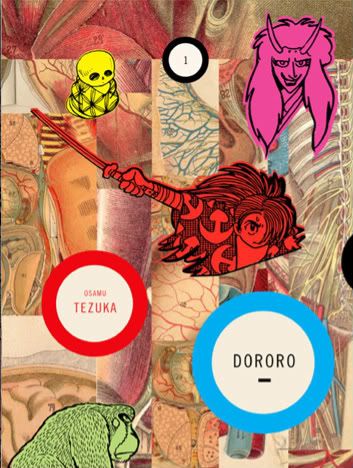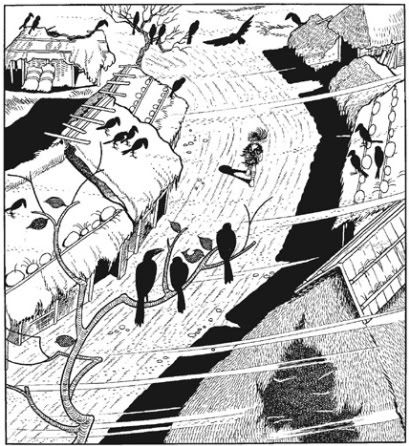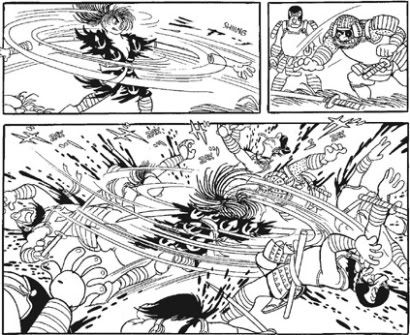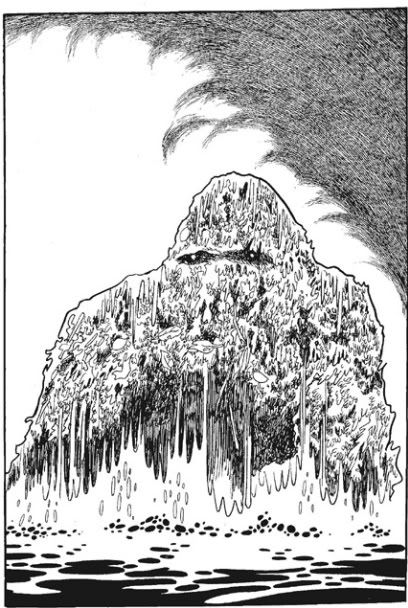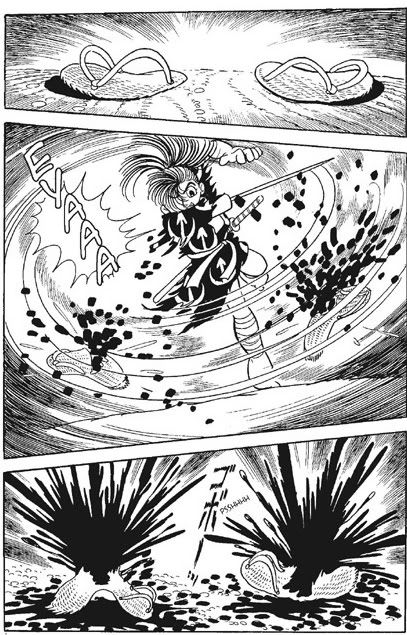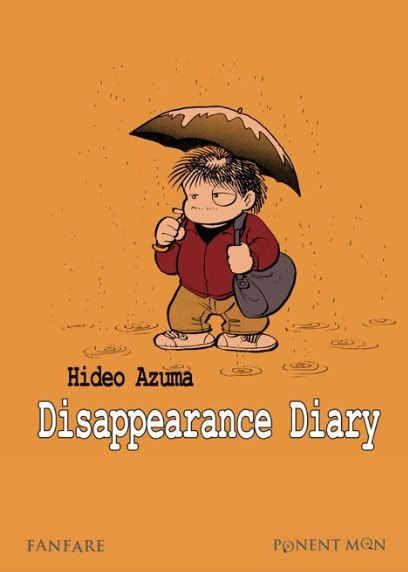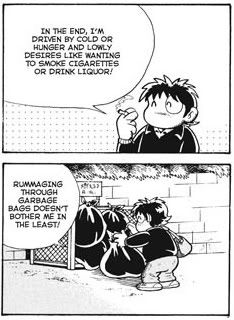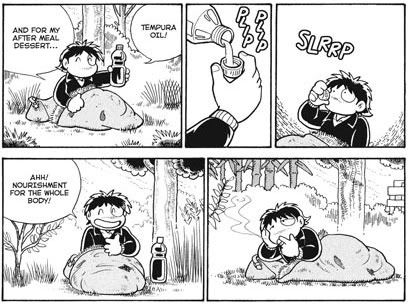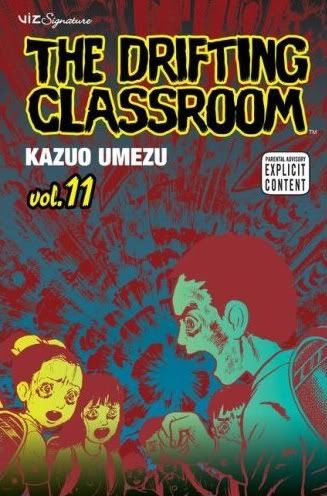(part 1)***
SATURDAY9:10 AM - The Hall of Breakfast, Although I Accidentally Typed "Hell" Back There for a Second, Which is a Pretty Telling Mistake:
Free breakfast: it makes hotels worth it. This particular hotel's breakfast was attended by everybody at once, which resulted in delicious toasted bedlam at the english muffin conveyer belt. The french toast sticks didn't look very good (though I appreciated the internationalism), so I picked up a sausage patty and plunked it down in between halves of my muffin. Chris congratulated me on my ingenuity, and then I spilled coffee on my arm, presaging greater pain to follow.
You see, we had to check out of our room before heading back to the show, which meant I had to pack up my bag with
Gary Panter and everything else I'd bought; it all fit nicely, I thought to use my Midtown Comics bag from Friday as a laundry sack, I had a big gold
Hellboy 2 bag left over from the Dark Horse booth to use for the show, and I
even noticed that I'd brought a shoulder strap... but I was hurting by the time we got outside. I was barely out the door and I was already trying to trick my body into believing that if I stuck one of my thumbs under the shoulder strap it'd offer that much relief from the strain.
We didn't have far to walk, luckily - the shuttle bus pickup spot was right across the street, although it took about half and hour for a shuttle to actually arrive, causing one impatient man by our side to storm back across the street and into the hotel.
He was never seen again.
10:20 AM - The Javits Center:
Chris is a worldly man, and wise to the ways of the New York Comic Con, so he knew to direct us right to the baggage check-in station, where you pay them $5.00 to put your things on the floor. I was handed a blue ticket, but the look of hate in the clerk's eyes as she dragged my suitcase-with-a-torso-in-it over to the pile was reward enough.
It was a lot more crowded on Saturday. A
lot, even that early. Lots more press -- I think I saw someone walking around for his high school newspaper -- and lots more cosplay. I saw several sandy-haired girls as Link (he's like Peter Pan, or
the Takarazuka Revue - guys needn't apply), a lot of Stormtroopers, a shitload of
Avatar: The Last Airbender, and a very impressive Hellboy with a light-up Right Hand of Doom. Some of the kids seemed to take the spirit of the thing as a chance to dress up in non-specific flashy outfits - there were girls reading Brandon Graham comics that looked like they just stepped out of one. A punk rock guy sneezed on my shoulder as we walked toward the Con floor; looking back, I guess it's not very punk rock to cover your fucking mouth, shitface.
10:30 AM - The Fanfare/Ponent Mon Booth (#2343):
It was still a half-hour until Chris needed to get to
the Marvel panel he was covering, and he asked me to show him over to Fanfare. Stephen Robson (Fanfare's founder and, unless I'm mistaken, sole full-time employee) was there, in an orange Ben Grimm shirt, prepared to please all comers. He's a really enthusiastic, gregarious fellow, always ready to supply a full rundown of everything he's got coming up, often pulling out a handy French edition of said upcoming book for your perusal.
Hell, I took a peek, before leaving Chris to his conversation.
Korea as Viewed by 12 Creators looks
great, with what seems to be an all-new European crew, including Igort(!) and Vanyda (of
The Building Opposite). Tons of upcoming Jirō Taniguchi too, including the five-volume
The Summit of the Gods (written by Yumemakura Baku; winner of an Excellence Price at the 2001 Japan Media Arts Festival), the one-off
The Quest for the Missing Girl (Taniguchi, back in noir mode!), the hugely acclaimed
Harukana Machi-E (aka:
Quartier lointain; winner of an Excellence Prize at the 1999 Japan Media Arts Festival
and Best Scenario at Angoulême 2003), and more of
The Times of Botchan. Let's hope their new distribution gets this stuff out broadly!
As noted before, Fanfare's table was part of a Little Britain in the small press area of the floor; Knockabout Comics was off to one side, and I picked up a copy of their 1989
Seven Deadly Sins anthology, featuring Alan Moore, Neil Gaiman, Bryan Talbot, Dave Gibbons and more. Where can you find 19-year old anthologies just sitting around in neat stacks? Comic Con!
10:40 AM - The Science Fiction Continuum Booth (#2140):
You can also find boxes of overstock anime dvds for $10 a pop ($8 if you buy five), with extra box set deals, after you fight your way through the bigger-by-the-moment crowd. Lots of hands on that anime; it was getting pretty hectic. I was sorely tempted to blow $45 on a complete run of the early '90s
Black Jack OVA series, but I settled on filling in various gaps - I'd never gotten Mamoru Oshii's 1984
Urusei Yatsura: Beautiful Dreamer movie on dvd, nor the original
Project A-Ko.
I learned with great delight that the Tatsuo Saito/Masaaki Yuasa mini-epic
Cat Soup was one of their best selling discs of the weekend; in case anyone hasn't seen Yuasa's current tv project,
Kaiba, it's like something out of a parallel world where Osamu Tezuka was a founding contributor to
Métal Hurlant, with scenery out of
Fantastic Planet and chase scenes in the arcade laserdisc tradition of
Space Ace. It's cool.
I was pretty happy with my purchases, and hurried away. I was jostled back and forth, and made to stand in place. Neko hats stumbled by; I nearly had to grab a cape to steady myself.
Five minutes later, I was back to the table.
"
Um, did you see a cell phone around here?"
"
Was it in some kinda case?"
"
Yeah."
The guy at the table smirked.
"
We get a couple phones left here every day."
"
Thanks..."
"
But you were the earliest."
10:55 AM - The Moment of Realization:
I didn't want to be on the floor anymore.
10:57 AM - The Escalator, Down:
That wasn't totally the Con's fault. I mean, it was a nice day out, and it was three hours until any panel I wanted to see. And I was in New York.
10:58 AM - The Concourse:
But there was something appreciably different about the floor of this 'big,' 'mainstream' con from the 'indy' ones I'd been to, SPX and MoCCA. Besides size and simple subject matter.
At SPX and MoCCA, the floor tends to resemble a buzzing mega-mall of comics. Yes, it's obviously possible to simply move around from table to table and get to know people and chat, and have that be your con experience, but I don't think it's much of a stretch to name capitalism as the primary force. The last time I was at SPX I picked up a neat-looking minicomic and asked the guy at the table if I could "
pick it up." That's a figure of speech; I didn't really want to just pick it up and take it away, and I feel silly even explaining it here, but sure enough, someone sitting nearby glared at me and snapped "
you have to pay for it." Yeah!
At those cons, the artists double as salesmen. Their items go directly to you. There's downsides to that; as
Bart Beaty once mused, "
I really think that there is a huge desire on the part of many fans to go to shows to buy books. That's what they most want to do... But how much shopping can you really do? And is that what comics are? An opportunity to shop?" The result is that the comics form is presented at such festivals as predominantly commercial, with aesthetic appreciation crunched under the hustle to move copies. Bart wasn't talking about a big-time
convention, video games and custom kimonos included, and maybe something like the NYCC would be ill-served by shifting focus to the art of comics... but that's getting off-topic. Exchange is primary on the floor, as I'm illustrating.
But something like the NYCC exchanges as much in anticipation and pursuasion as immediacy,
purchase, which maybe makes it more of a proper industry trade show, as I understand it. At SPX or MoCCA, the sale is most often tethered to the
person, along with the perception that with the person goes the work. There's
publishers around, sure, but the locus of the exchange remains on the floor itself, personal books vanishing with the tables at weekend's conclusion.
At a show like the NYCC, that feeling is captured in the Artist Alley, off to one side. But the large publishers? The dealers? I can find it all elsewhere, somewhere. I'm pretty much part of this stream of commerce, in that I know where to look to get things, and as such I don't need to do much more than stop and glance at 1/5 of the booths, and nothing brings me back. I guess I could line up for a smile and an autograph from a favorite artist, but I've never been big on that kind of formalized interaction, and it's hard to talk more deeply in the middle of a big hustle; the floor isn't built to hold that.
That's not
all a con like the NYCC has to offer -- like I've mentioned before, the very size of comics offers a certain closeness, as indicated by the woman behind me who crowed about accidentally chit-chatting with Frank Miller while smoking outside the building -- and if you bring a whole gaggle of friends you can make a day of the sheer
occasion of it all, but me? No interesting panels to attend?
I felt like going outside, and I'm a capitalist swine. I
wanted to shop. I've never felt like that at a smaller con, where I'd have already spent more time on the floor. Even the panels at a show like this are often geared toward hype and tease, and there's nothing implicitly wrong with that, given the venue, but I don't feel the need to be
present for it. I know my internet. I'll find things out.
11:00 AM - 33rd Street:
So I hit the street. Walking across town, I could sense how the Con had affected my psychology; on Friday, I had avoided accepting any handouts or leaflets, but hours of people thrusting postcards and papers on the Con floor had me willing to pick things up outside too. Er, I think I might be a Scientologist now.
I picked up a free Starbucks card (good for a tall coffee YES). I picked up a café brochure. One guy was fiddling with his cards, and I stuck my hand right out. He laughed.
"
Oh man..."
11:35 AM -The Empire State Building:
Holy shit, the Empire State Building! I hadn't been there since I was 15 or something!
Did you know there's fuckall to do on the ground floor of the Empire State Building? Well, there was a
King Kong exhibit in a dark corner, but... unless you want to hit the New York City Skyride IN 3D... there isn't even a men's room. Nice walls, though.
11:40 AM - Jim Hanley's Universe:
Again, capitalist swine.
Hanley's is a nice shop; it actually reminded me a
lot of one of my local shops in terms of space and decor, if not selection. I couldn't find a single Fanfare/Ponent Mon book, but I saw a lot of everything else. It's a
crowded place, though, and the organization takes some getting used to (if you don't want to ask for help or anything, which maybe you do). They had a 25% off sale going, and an event with Ariel Schrag (whom I saw at the Con) later that evening.
The best part for me by far was the dead-cheap blow-out manga bin, which had some treasures tucked away. I found a nice copy of
Saber Tiger, one of VIZ's old Spectrum Editions from the early '90s with the ribbed softcover dustjackets, a line that also included the awesome
Hotel Harbour View (by Natsuo Sekikawa and the aforementioned Jirô Taniguchi) and the considerably less awesome
Shion: Blade of the Minstrel (by Yuu Kinutani). It's a collection of two early stories by Yukinobu Hoshino (of
2001 Nights and
The Two Faces of Tomorrow), very heavily influenced by the sci-fi pulps. Which means the first tale has sexy ladies in skin-tight spacesuits using ray guns to fight off prehistoric beasts
for the future of humankind.
The second story is titled
The Planet of the Unicorn. I don't think further elaboration is necessary.
But the big,
big find was an untranslated back issue of
AX,
Vol. 40 (August 2004). AX is the descendent of
Garo, the foremost 'underground' manga anthology for decades, and maintains an aesthetic stance that wobbles delightfully from crazed scribbling to super-slick visual design; it represents the avant-garde of Japanese comics as much as any six-per-year publication probably can. It's a chunky thing, about the same in dimension as the old digest-type SPX anthologies, and filled with comics and articles and historical features on porn and all the good shit.
Vol. 40 in particular has a cover feature on Shizuka Nakano (of
Le Piqueur d’étoiles), but the most striking bits for me were a
Kotobuki Shiriagari serial chapter that consisted of nothing but huge splashes of fire and destruction and ruined, gawking faces, and a very funny-looking story by
Michihiro Hori, who has a great visual style. There's also a column(?) by the great King Terry, and a little thing by
Takashi Nemoto, soon to have an English-language book out from PictureBox (which is maybe the North American publisher closest to the AX 'style' in terms of its releases). There's also a story by a person whose name I can't make out, but it's called
Ox Cry and features a death metal guy whipping out his penis on stage and ejaculating into the face of a concert promoter, I think. I wish it was in English.
12:20 PM - Under the Lunchtime Sun:
It was so nice out that I walked to a park and sat in it.
1:40 PM - Back At the Con, By the Heavy Metal Booth (#1813):
By this time Chris was already covering his last panel of the weekend,
the Legion of Super-Heroes gala, and I was ready to hit a panel myself. But I couldn't help but noticing the
Heavy Metal booth - there was a
line.
I don't mean to impugn Heavy Metal; it had a nice booth, and everything in it was 50% off. I wound up (finally) getting that reissue of Lob's & Pichard's
Ulysses. And Kevin Eastman was manning the ship the whole time, it looked like.
Ah, that was it.
A quick peek at the makeup of the line revealed a single unifying element: Turtles. Limited edition NYCC
Teenage Mutant Ninja Turtles toys, and Peter Laird was signing them at the NECA booth across the floor, which meant that everyone was flowing over to pick up Eastman's handwriting too. It looked like he came prepared with copies of his
Teenage Mutant Ninja Turtles Artobiography book. God, that was his first comic, those Turtles. A Frank Miller parody comic, and it'll always be at his side.
I then tried to move back upwards to one of the main arteries on the floor, only to run into yet another autograph line, an extra-long one. What rock star could it be?
Why, Mark Evanier! With his
Kirby: King of Comics book. I couldn't actually
see Evanier, but I imagined he was wearing rock star clothes, like a moss green suit with matching tie and a black dress shirt, and a orange mink coat. And a signing pen bejeweled with opal and ruby.
When I win the Eisner for Best Comics Journalism Via Blogger Default Template, I'm gonna dress just like Mark Evanier.
2:00 PM: Grant Morrison Spotlight Panel (Room 1E10-1E11):
This was the only panel I sat through from start to finish, and the hour flew by. It was standing-room-only, and I was one of the assholes standing, but I didn't care. I didn't catch the moderator's name, but he got really into
the opening presentation, reading a compilation of Morrison quotes aloud,
dramatically, as a big screen flashed images from various comics. I was very happy to see bits of
Bible John and
The New Adventures of Hitler flash by; the crowd applauded
Arkham Asylum,
We3 and, interestingly,
Vimanarama.
As soon as the lights came up, Morrison demanded questions from the crowd - the entire panel would consist of audience interaction. A lot of the questions were pretty simple, familiar ones; I'm sure Morrison has some of the answers timed down to perfection after hundreds of interviews, as it goes for almost everyone who does a lot of publicity. Still, it was good to
hear the man
saying things - there's no doubt in my mind that some of his comments, stripped of inflection and plopped down on a page or screen, might seem prickly or irritated, but Morrison is a soft-spoken, ingratiating presenter, who puts a lot of obvious good humor behind his words. He's quite down-to-earth.
There's a few reports from the panel online,
here and
here and
here; the second one does the best job of capturing Morrison's tone, although I could have sworn his answers were more poetic at times. When someone said they didn't understand the final issue of
The Invisibles,
I heard Morrison say "
Of course you did! The words are what you read, and the pictures are what you saw!" But hey, I was in the back.
He'd announced a pair of new creator-owned series at
the Vertigo panel on Friday (I'd only find this out later), which got a few fleeting references - they're called
War Cop (about post-9/11 fetishization of the soldier) and
Me and an Atomic Bomb (concerning the daughter of an infamous villain and the secret agent who's after her). But much time was spent on the two new
Seaguy series, which Morrison sees as a trilogy charting the title character's metaphorical growth from a naïve child to an angry adolescent to a mature adult.
The first Seaguy is my favorite Morrison work of the 21st century, along with
The Filth (which Morrison ranked with
Flex Mentallo as among his personal favorites - you should have seen his Max Hardcore impression). I've come to see it as an allegorical comment on writing better superhero comics, redolent with the futility that seemed to mark the Marvel mutant books following his
New X-Men. The second Seaguy will see the title character revamped into a bullfighter but longing for something else, while the third will see him journeying to the site of the Anti-Dad's crash (Australia) to confront the concept of death in a superhero world. That last bit seems of particular fascination to Morrison these days, with
All Star Superman and
Batman both prepping their heroes for doom.
Lots of fun, and tiny bits of revelation. I was struck by a passing mention of how reading negative reviews of
The Authority helped convince Morrison to "
fuck it" regarding the final issue of his run (#3 was apparently written, but never illustrated). He stood up for Joel Schumacher's
Batman & Robin (the colors were great!), and recommended the 2004 Lt. Blueberry movie
Renegade (
Blueberry: L'expérience secrète) for the best
drug experience scene on film (although he warned the crowd against watching the rest of it). Con workers at the back of the room kept telling him to wrap it up, but nobody at the front listened.
When it all finally ended, we crashed into a huge line of kids in costumes waiting to see the Avatar preview that was coming up next. It was good and surreal.
3:10 PM - The Food Court:
I called Chris on my somehow not-lost cell phone, and he warned me against trying to get into the press room again. I don't try; I
succeed. He also told me it'd be ok to get lunch on my own, so I went over to an Italian stand for some tasty $9.50 chicken parmesan with penne in vodka sauce. There was also bread, but it was a hamburger bun ripped in half. That really disturbed me, for some reason.
4:00 PM - The Dark Horse Booth (#823):
I went back up to the floor, then Chris called to meet him. Just as I began walking by the Dark Horse booth, Mike Mignola (and I think the Hellboy 2 cast?) showed up. Immediately, everything in a 20-foot circumference was a thatch of bodies and flashing lights. It was impressive.
4:08 PM - The IGN.com Theater:
Chris looked really happy to have gotten all the news out to the world beyond the walls of the Javits Center. I suggested we celebrate by taking in a preview of
Frank Miller's All Star Denny Colt: The Motion Picture. Sadly, we were told that the film previews were running late, and the sneak peek at
The Incredible Hulk was just getting started. We left to go eat (er, Chris ate; I offered advice and support).
I later saw
the official teaser online. All that unreal, over-the-top jumping and posing and acting makes it look like a contemporary
tokusatsu superhero movie; just add bright colors and you'd have Hideaki Anno's 2004
Cutey Honey movie. A lot of people hated
that too.
5:20 PM - The Bag Pile:
And so, we walked around a little bit more, pretended we understood the words in various French comics, and got ready to leave. It was a little disorganized at the baggage table; All Star Super Lois Lane was poking around for something she lost, and Wolverine was getting antsy behind us. The woman at the counter took my ticket and found my bag, and motioned for me to come over.
"
That thing's heavy," she said, "
I'm not carrying it."
5:45 PM - Madison Square Garden:
We didn't visit the Red Light district, back when I was a teenager. We didn't even have a sense of how the streets worked. We only remembered the basics of our paths, and backtracked appropriately when we were done eating. No strays, no mess.
It's easy to keep your bearings in the middle of New York City, as an adult. It's all mapped and logical. Chris pointed our way to the station, and reading the streets was simple. It reminded me of this old trailer park I used to deliver pizzas to when I was in high school. We called it the Abyss, because it was so easy to get lost in its mania of inchoate designations. You could drive for hours, and find nothing.
I still can't give directions. Not in this town. But I can read a grid, and I like to walk, and that's enough for a tourist in a city of tourists, gone off to a show in a room, stands finely apportioned. I'm a romantic, but I wonder if my guts aren't truly inclined toward the intuition of rising and falling numbers, analogized by the debit of dollars leaving a wallet.
My shoulder was breaking, but it didn't.
7:15 PM: Another Train:
Seriously, that bag was too heavy to dig anything out of.
But I bet I could have lifted it to whack the screaming kid behind me.
***
SUNDAY10:30 AM - My Bathroom:
Fucking hell! I left my toothbrush at the hotel!
Fuck you, New York Comic Con!! I HATE YOU FOREVER.
RATING:
CRAPLabels: A Shape of Things
